The Museum / History
1947-1991 The State Gallery of Armenia
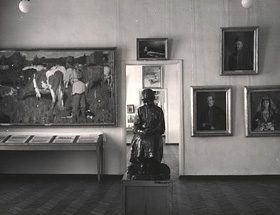 In 1947 the museum was renamed the “State Gallery of Armenia” until 1991, when it was again renamed the “National Gallery of Armenia”. The year 1948 marked the beginning of reconstruction of the museum building.
In 1947 the museum was renamed the “State Gallery of Armenia” until 1991, when it was again renamed the “National Gallery of Armenia”. The year 1948 marked the beginning of reconstruction of the museum building.
Little by little the gallery expanded its scope of activity. For instance, in 1948, partnership with the Art Sector of the Academy of Sciences of Armenia two works – “The Miniatures of Armenia” and “Armenian Art of the 19-20th Centuries”, – were prepared for publication.
In 1951, after 27 years of running the gallery, R. Drambyan left his post as Director, but his cooperation with the gallery continued for years (he was a member of the Scientific Council, an irreplaceable advisor, and in 1982 published his book “The State Gallery of Armenia” in Russian). For only a year the gallery was administered by art historian Vahan Harutyunian and in 1952-1962 – by Ruben Parsamyan.
In this period the gallery continued its activity a steady direction, proceeding with the investigation and expansion of the collections, organization of private exhibitions of Armenian artists, and the opening of the Department of Manuscripts and Documentation Fund headed by Daniel Dznuni. The latter was assigned to prepare the “Dictionary of Armenian Art Historians” for publication (issued in 1977) and the album “The State Gallery of Armenia”, whose introduction was written by R. Drambyan (1956). On the basis of existing collections new research departments were created. For this purpose, graduates of the I. Repin Leningrad Art Institute were recruited to staff the research department of the gallery. The successful generation change ensured future development of the research activity of the museum.
In 1946 Yerevan welcomed the distinguished artist Bedros (Bedo) Kontradjian from Paris, who donated fifty paintings and about 600 graphic works to the museum. In 1958 another French-Armenian compatriot Hakob Arakelian organized the accumulation of famed sculptor Hakop Gurdjian’s artistic heritage, including busts, compositions, graphic works and important archive material. The total number of works altogethercomprising to 400 pieces, was transferred to the gallery. In 1959 the museum staged an exhibition of the sculptor’s works, which found a warm response in public, especially among young sculptors.
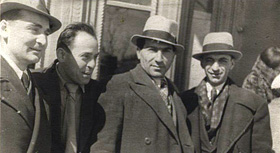 In 1962 the painter and stage designer Armen Chilingarian was appointed Director of the gallery after the acting Director Ruben Parsamian left the position to take up another post. In the years of his administration, the museum collections were considerably enriched on the initiative of the art historian of the Department of Russian and West-European Art Mary Sargsian. In this period the gallery acquired invaluable works by well-known 20th century well-known Russian painters R. Falk, P. Filonov, I. Mashkov, A. Kariov, N. Altman and others. 17-18th century Russian icons were sent from the the museums of Kremlin, Moscow. In 1965 the first private exhibition of Robert Falk’s works was staged, with the assistance of his widow A. Shchekin-Krotovo. The exhibition was an unprecedented phenomenon in those years, as the painter had been disgraced for political reasons. This exhibition of Falk’s works was followed by another one in Novosibirsk, and later in Moscow. The gallery purchased over a dozen works from this exhibition, and another three were gifted to the museum by the painter’s widow.
In 1962 the painter and stage designer Armen Chilingarian was appointed Director of the gallery after the acting Director Ruben Parsamian left the position to take up another post. In the years of his administration, the museum collections were considerably enriched on the initiative of the art historian of the Department of Russian and West-European Art Mary Sargsian. In this period the gallery acquired invaluable works by well-known 20th century well-known Russian painters R. Falk, P. Filonov, I. Mashkov, A. Kariov, N. Altman and others. 17-18th century Russian icons were sent from the the museums of Kremlin, Moscow. In 1965 the first private exhibition of Robert Falk’s works was staged, with the assistance of his widow A. Shchekin-Krotovo. The exhibition was an unprecedented phenomenon in those years, as the painter had been disgraced for political reasons. This exhibition of Falk’s works was followed by another one in Novosibirsk, and later in Moscow. The gallery purchased over a dozen works from this exhibition, and another three were gifted to the museum by the painter’s widow.
A year later, thanks to dynamic negotiations, Yerevan hosted another significant exhibition – Pablo Picasso’s graphic works from Ilya Ehrenburg’s collection.
The 1960s were especially fruitful for the enrichment of the museum collection. Aghasi and AzganushDarbinian from Paris donated 70 illustrations of La Fontaine’s fables, drawn by T. Polad, as well as 25 etchings by E. Chahine to the gallery. They also organized the transfer of over 100 works of O.Alhazian artistic heritage to the gallery. Upon his visit in Yerevan to stage a private exhibition, celebrated American artist Rockwell Kent donated 14 of his paintings to the gallery. French-Armenian sculptor Daria Kamsarakan presented two sculptures made of marble and bronze. Following the exhibition of contemporary French-Armenian painters held by the French-Armenian Cultural Union, sixty-three of the exhibited works were sent to Armenia as a donation.Lebanese-Armenian artists also donated their axhibited works to the gallery. Invaluable were works by Italian-Armenian sculptor Nvard Zarian -twenty-three of her works have found their unique place in the Gallery’s collection of sculptures.
There were of corse far more donations than those mentioned.Taking into account the acquisition of Soviet Armenian artists’ works from private and republican exhibitions and the transfers from the collections of the Ministry of Culture, one gets a better idea of the whole acquisition process.
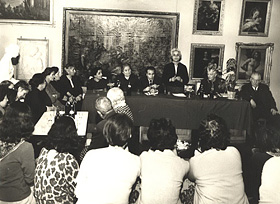 In 1963 by the decision of the research council of the gallery, V. Baghdasarian and H.Siravian undertook the restoration of the curtain of G. Sundukian National Academic Theatre (originally designed by Martiros Sarian) Its installment in a special hall of the gallery earned the great painter’s praise.
In 1963 by the decision of the research council of the gallery, V. Baghdasarian and H.Siravian undertook the restoration of the curtain of G. Sundukian National Academic Theatre (originally designed by Martiros Sarian) Its installment in a special hall of the gallery earned the great painter’s praise.
In 1967-1986 the gallery was run by people’s artist Edward IsabekIan. The first years of his activity coincided with the construction of the new building for exhibitions (designed by architects M. Grigorian, A. Ghazarian).
In 1977 the museum was reopened with a new display of its collections. A few years later the building on Nalbandyan Street was put into use. The four floors of the building housed the collection repositories, restoration studio, research departments, and the department of inventory and conservation. Also opened the the research departments of sculpture, decorative-applied art and the department of branch management. This department coordinated the work of its satellite museums running in different regions of the republic, namely Etchmiadzin, Hrazdan, Jermuk, Martuni, Leninakan, Kirovakan, as well as the exhibition halls in Alaverdi and Yeghegnadzor. 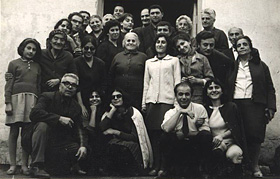 The main objective of the branches was to satisfy the artistic need of the population living far from the cultural centers of the capital. A collection of works of Armenian artists’ was selected from the museum collections to be displayed as a permanent exhibition in the new building. It also hosted regular thematic exhibitions and private exhibitions of local painters.
The main objective of the branches was to satisfy the artistic need of the population living far from the cultural centers of the capital. A collection of works of Armenian artists’ was selected from the museum collections to be displayed as a permanent exhibition in the new building. It also hosted regular thematic exhibitions and private exhibitions of local painters.
In 1972, Director of “Georgy Yakoulov’s Friends’ Club” in Paris, painter Rafael Kherumian addressed a letter to the Armenian Government expressing willingness to pass the paintings and graphic works of renowned artist Georgi Yakoulov to Armenia. The responsibility of transferring Yakoulov’s works from Paris to Yerevan was assigned to the gallery. Apart from expanding the gallery’s collection, the donations significantly increased Armenian fine arts collection of the early 20th century. Soon after, the artist’s retrospective exhibition was held, with the participation of various museums of the Soviet Union. The exhibition was then taken to Moscow to be displayed in the State Museum of Eastern Art.
At the same time the State Gallery of Armenia furthered its ties with the Moscow and Leningrad museums in the spheres of research and exhibition work. The Hermitage compiled and held a memorable exhibition of the canvases of the French impressionists from its collection. The paintings of W. Kandinsky and M. Chagall represented the State Gallery of Armenia in joint international exhibitions. Representatives of the gallery were regular participants at the annual symposiums of the International Council of Museums.
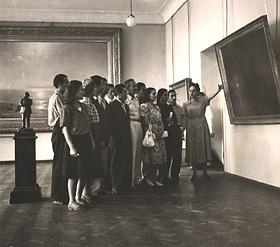 Under E. Isabekyan’s administration the gallery reported considerable progress. This was in part, due to the awareness of the importance to develop museum specialists, as well as desire to purposefully expand, properly conserve and thoroughly investigate the existing collections.
Under E. Isabekyan’s administration the gallery reported considerable progress. This was in part, due to the awareness of the importance to develop museum specialists, as well as desire to purposefully expand, properly conserve and thoroughly investigate the existing collections.
Experienced senior registrar Yevgenya Khachatrian was replaced by Alis Bakrajian, who had already successfully inherited her forerunner’s experience, devotion and long years of museum service. A number of young painters assembled around the only qualified painter-restorer in Armenia, Vardges Baghdasarian apprentice to L. Durnovo, Head of the Restoration Studio.Baghdasarian tutored them, and with great devotion passed on his experience and professional secrets to them. Acquiring skills, mastery and qualification in the advanced training courses at the museums of Moscow, Leningrad, and I. Grabar Scientific Restoration Center, these young specialists shouldered the significant responsibility of restoring and conserving the museum objects.
Another is another remarkable event of this period, decided by the scientific council of the gallery, was a documentary reproduction of the fresco on Kobayr Monastery (12-13th century). It found its place in the permanent exhibition of the museum. Further, the Armenian expedition successfully accomplished the replication of the central apses of St. Stephen church (15th century) in Theodosia and the Holy Cross Monastery (1338) in Crimea.
The heads of the gallery branches and guides were retrained in the State Hermitage and the State Russian Museum. Each year the above-mentioned museums, especially the Hermitage, hosted museum researchers working in the areas of Russian and European painting, graphic and applied art. The collaboration with prominent Russian art historians made it possible to decipher the works of certain artists and schools in the Gallery’s collection.
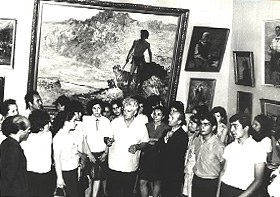 This period is also prominent for the publication of a number of album-catalogues, namely, “Hakob Hovnatanian and his Predecessors”, “Sargis Khachatrian”, “Yeghishe Tadevosian”, “Vano Khojabekian”, “Sedrak Rashmajian”, “Sedrak Arakelian”, “Edgar Chahine” and others. Thanks to continued donations the Gallery’s collections further expanded. The renewed momentum of these donations recalled the enthusiasm of the Diaspora’s Armenians at the time of the Gallery’s foundation between 1920-1930.
This period is also prominent for the publication of a number of album-catalogues, namely, “Hakob Hovnatanian and his Predecessors”, “Sargis Khachatrian”, “Yeghishe Tadevosian”, “Vano Khojabekian”, “Sedrak Rashmajian”, “Sedrak Arakelian”, “Edgar Chahine” and others. Thanks to continued donations the Gallery’s collections further expanded. The renewed momentum of these donations recalled the enthusiasm of the Diaspora’s Armenians at the time of the Gallery’s foundation between 1920-1930.
The European art collection was enriched by the acquisition of “Portrait of Gajzágó Salomon” painted by the Hungarian artist Ignacz Roskovics and donated to the gallery by the Armenian Society of Hungary. The portrait is now displayed in the permanent exhibition of the gallery. Famous writer and dramatist Gajzágó was an Armenian by origin, whose ancestors had moved to Hungary in 1672. He was one of the organizers of the battle for the liberation of the Hungarian people in the 19th century.
Another contribution to the museum collection were the donations of the painter Rafael Kherumian from Paris. He presented the canvases “Portrait of a Man” by an English artist Marcus Gerards and “Portrait of a Man” attributed to the Spanish painter Francisco de Goya. The US Union of All-Sebastia-Armenians donated “The Anointing of David” painted by Antonio Molinari, an artist belonging to the Venetian school. The subject is taken from the Old Testament and the painting was completed by the end of the 17th and beginning of the 18th centuries. Another one of his contributions was the marble artwork “Bust of Caesar” sculpted by Italian sculptor G. Biagiotti. Sculptor Khoren Der-Harootian entrusted Auguste Rodin’s drawing “The Model” to the gallery. Meanwhile, French-Armenian Albert Ashchian gifted three paintings by the contemporary Spanish artist Juan Ripolles.
In the 1970’s donations also triggered the expansion of the Russian art collection. Thus, Zagorsk (an archive of artworks) contributed graphic works of 20th century prominent Russian painters M. Le-Dantu, L. Bakst, O. Rozanova, V. Konashevich, and others to the museum collection. The All-Union Center of Productive Painting donated nine sculptors by renowned sculptress Sara Lebedeva and a number of paintings by V. Rozhdestvensky, V. Stozharsky, S. Savitskas, and others.
Donations also included the works of Armenian artists. Collector Aghasi Darbinian (Paris) gifted a pastel by the great engraver Tigran Polad. Painter R. Jeranian (Paris) presented fourteen etchings by the same author. Jansem sent thirty of his engravings and drawings, while Carzou gave 118 lithographs. Vardush Muradian, Arshile Gorky’s sister, entrusted the renowned artist’s drawing “Seated Woman” to the gallery.
In 1975 the “Aurora” publishing house issued the comprehensive album “The Art Gallery of Armenia” compiled by N. Mazmanian (in English and French).
In the 1980’s a number of jubilee exhibitions were held, namely those of Hakob Gyurjian, Sedrak Rashmajian, Sedrak Arakelian, Hakob Kojoyan, Georgi Yakoulov. All exhibitions yielded printed catalogues.
Thanks to the large-scale exhibitions organized in different cities of the USSR, Armenian artists gained wide recognition. Tbilisi, for instance, hosted an exhibition of Gevorg Bashinjaghian’s works, while Kaunas welcomed Sedrak Arakelian. Makhachkala was exposed to Armenian painting and applied art, Lvov learnt about the 18-20th century Armenian art, weaving, and silver art, while Kiev was granted an opportunity to enjoy the 19-20th century Russian painting through the Gallery’s collection.
In May of 1986 Edward Isabekian left his post of the Director, terminating his nineteen year persistent service in this cultural center. In July of the same year the office was assumed by Alexander Ter-Gabrielian, who for years had worked as Head of the Art Department of the Armenian SSR Ministry of Culture, and was well aware of the gallery’s activity.
In the time of Soviet rule, the gallery was included in the All-Union cultural system, which ensured its participation in the conferences and preparation courses, organized throughout the country. As a member of the Soviet Division of the International Council of Museums (ICOM), representatives of the State Gallery were usual invitees to the sittings held in the capitals or major cities of different Soviet republics – Moscow, Lvov, Alma-Ata, Vladimir, Vilnius, etc. These meetings reinforced the ties between different museums within the Soviet Union. On the initiative of the Hermitage the Armenian public was due to enjoy the exhibitions “Western European Engraving of the 18th Century” and “Western European Landscape of the 19th Century”. On the occasion of the RSFSR cultural days in Armenia, the exhibition “Russian Soviet Landscape” was staged in the State Russian Museum of Leningrad. The retrospective exhibition highlighting the culture and art in the Armenian SSR was organized in Moscow. The gallery also organized exhibitions of its collection in Sochi, Alma-Ata, and Izmail.
- 1921-1935 Art Department of the State Museum
- 1935-1947 The State Fine Art Museum
- 1947-1991 The State Gallery of Armenia
- 1991-2011 The National Gallery of Armenia